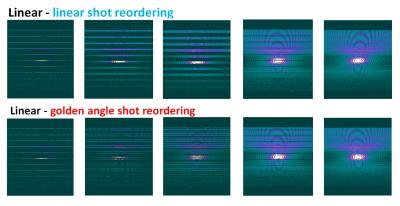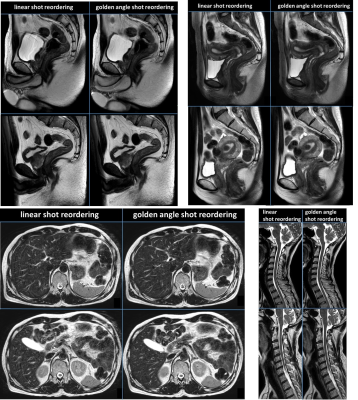4146
Improvement of 2D-multi-slice, multi-shot Cartesian T2-weighted TSE using golden angle shot reordering1Radiology, Tokyo Metropolitan Police Hospital, Tokyo, Nakano-ku, Japan, 2Graduate School of medicine Health Sciences, Images Analysis, Tohoku University, Sendai, Miyagi, Japan, 3IS Business Group, Philips Japan, Minato-ku, Tokyo, Japan
Synopsis
2D multi-slice, multi-shot Cartesian TSE sequence is frequently used for routine MRI but it is sensitive to motion. We evaluated the feasibility of golden angle shot reordering for 2D-multi-shot TSE with 60 patients. Golden angle shot reordering reduced effectively ghost artifacts by randomly filling in each segment of Cartesian k-space. We demonstrated that golden angle shot reordering intrinsically has a motion robustness without penalty for image quality and scan time. This technique might be useful for all anatomies in routine clinical examination..
Purpose
Two-dimensional multi-slice, multi-shot Cartesian TSE (2D-MS TSE) sequence is frequently used for routine magnetic resonance imaging (MRI). In 2D-MS TSE, various motion-compensation techniques, such as single-shot sequence, faster sequences with breath-hold acquisition, and signal averaging with multiple NSA, correspond to the motion of the body1,2, but such techniques potentially deteriorates image quality. With the aim of addressing this issue, recent studies have reported the utility of golden angle radial sampling3-4. To apply motion-compensation effects of golden angle sampling for Cartesian TSE, a new k-space shot reordering, called golden angle shot reordering, is developed. In this study, we investigate the effects of golden angle shot reordering in 2D-MS TSE.Theory
In Cartesian TSE, k-space is basically divided segments into number of echo train length, and actual order in each segment (shot order) is filed sequentially from the lower end to the upper end (linear shot reordering) [Fig.1,2]. On the other hand, golden angle shot reordering performs unique filling-up method based on calculated golden angle step in each segment [Fig.1, 2]. Theoretically, this technique does not adversely affect for the image quality and scan time.Experiments:
Results
Golden angle shot reordering provided good image quality with reduced motion artifacts. Table.2 summarizes the VE scores. Compared to conventional linear shot reordering, golden angle shot reordering was superior in any items, only except with regard to blurring artifacts in the pelvis. Overall image quality of golden angle shot reordering was significantly better than that of linear reordering in all anatomies. Ghost artifacts of golden angle shot reordering was significantly better than that of linear reordering in the pelvis and spine. Blurring artifacts of golden angle shot reordering was significantly better than that of linear reordering in the spine.Discussion and Conclusion
Golden angle shot reordering reduced effectively ghost artifacts by randomly filling in each segment and thus the influence of motion was distributed entire the k-space like a noise. We demonstrated that golden angle shot reordering intrinsically has a motion robustness without penalty for image quality and scan time. This technique might be useful for all anatomies in routine clinical examination.Acknowledgements
No acknowledgement found.References
[1] Chavhan GB et al; Radiographics 2013(33):703–719
[2] Yang RK et al; RadioGraphics 2010;30(1):185–199.
[3] Winkelmann S et al; IEEE Trans Med Imaging. 2007 Jan;26(1):68-76.
[4] Chandarana H et al; Proceedings of the 20th Annual Meeting of the ISMRM; Melbourne, Australia. 2012;
Figures




